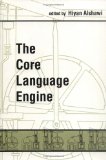

 |

|

Sold Out
Book Categories |
Preface
1 Introduction to the CLE
1.1 Language Analysis and Interpretation
1.2 Overview of CLE Components
2 Logical Forms
2.1 Levels of Logical Form in the CLE
2.2 Resolved Logical Form
2.2.1 The Predicate Logic Part
2.2.2 Higher Order Extensions
2.2.3 Generalized Quantifiers
2.2.4 Tense, Aspect, and Modality
2.2.5 Statements, Questions, and Commands
2.2.6 Events and States
2.2.7 Infinitives
2.2.8 Nominal Modifiers
2.2.9 Distributive and Collective Readings
2.2.10 Measure and Kind Terms
2.2.11 Predicate Nominals
2.2.12 Comparatives and Superlatives
2.3 Quasi Logical Form
2.3.1 Syntax of the QLF Language
2.3.2 Quantified Terms and Descriptions
2.3.3 Anaphoric Terms
2.3.4 Anaphoric Relations and Formulae
3 Categories and Rules
3.1 Constraints, Components, and Rules
3.2 Categories for Linguistic Analysis
3.3 CLE Categories
3.4 Category Unification and Subsumption
3.5 Boolean Expression Feature Values
3.6 Feature Sets, Defaults, and Macros
3.7 Internal Category Representation
3.8 Grammar Rules
3.9 Syntax and Morphology Rules
3.10 Semantic Rules
3.11 Lexical Entries
4 Unification-Based Syntactic Analysis
4.1 Theoretical Background
4.2 Subcategorization
4.3 Start Categories
4.4 Sentence Types
4.5 Subject-Auxiliary Inversion
4.6 Unbounded Dependencies
4.7 Passives
4.8 Conjunctions
5 Semantic Rules for English
5.1 Semantic Rules and Senses
5.1.1 Semantic Rules
5.1.2 Sense Entries
5.1.3 Morphological Derivation
5.2 General Principles of the CLE Semantics
5.2.1 Building Translations by Unification
5.2.2 Unbounded Dependencies
5.2.3 Threading ofAntecedents Lists
5.2.4 Lexicalization of the Semantics
5.3 The Semantics of Specific Constructions
5.3.1 Complements of 'be'
5.3.2 Verb Phrases
5.3.3 Adjective Control Phenomena
5.3.4 Nbars
5.3.5 Noun Phrases
5.3.6 Prepositional Phrases
6 Lexical Analysis
6.1 Tokenizing the Input
6.2 Segmenting the Tokens
6.3 Recovering from Unknown Tokens
6.3.1 Inferring Proper Names
6.3.2 Using an External Lexicon
6.3.3 Spelling Correction
7 Syntactic and Semantic Processing
7.1 Parsing
7.1.1 The Basic Parsing Algorithm
7.1.2 Elaborations of the Basic Algorithm
7.1.3 Grammar Compilation
7.2 Semantic Analysis
7.3 Morphological Processing
7.3.1 Word Parsing
7.3.2 Sense Derivation
7.4 Ambiguities and Packing
7.4.1 Representing Local Ambiguities
7.4.2 A Structure Sharing Method
7.4.3 CLE Packed Structures
7.4.4 Parallel Parsing
8 Quantifier Scoping
8.1 The Quantifier Scoping Problem
8.2 Scoping Rules and Preferences
8.3 The Scoping Algorithm
8.3.1 Soundness
8.3.2 Constraints
8.3.3 Irredundancy
8.3.4 The Basic Algorithm
8.4 Refinements to the Basic Algorithm
8.4.1 Preferences
8.4.2 Coordination
8.4.3 Equivalent Logical Forms
8.4.4 The Full Scoping Relation
8.5 Implementation
9 Sortal Restrictions
9.1 Applying Sortal Restrictions
9.2 Encoding Sorts as Terms
9.3 The External Representation for Sorts
9.4 Specifying the Sort Hierarchy: Notation
9.5 Specifying the Sort Hierarchy: An Example
9.6 Recent Developments
10 Resolving Quasi Logical Forms
10.1 Deriving LFs from QLFs
10.1.1 QLF Constructs
10.1.2 QLF Resolution
10.1.3 Reference Resolution Rules
10.2 Anaphoric Terms
10.2.1 Pronouns
10.2.2 Bound Variable Anaphora
10.2.3 Definite Descriptions
10.2.4 Determiners and Quantifiers
10.2.5 Collective Readings
10.2.6 Attributive Descriptions
10.2.7 Plural Pronouns and Descriptions
10.2.8 Unbound Anaphoric Terms
10.3 Context Model
10.4 Constraints on Resolved LFs
10.4.1 Sortal Constraints
10.4.2 Binding Constraints
10.4.3 Configurational Constraints
10.5 Anaphoric Relations and Formulae
10.5.1 Implicit Relations
10.5.2 Possessive Pronouns
10.5.3 'One' Anaphora and Ellipsis
10.5.4 Tense Resolution
10.6 Further Work on QLF Resolution
11 Lexical Acquisition
11.1 The Task of Lexical Acquisition
11.2 The Strategy Adopted
11.3 Assumptions behind the Strategy
11.3.1 Idiosyncrasy and Uniformity
11.3.2 Defining Paradigms
11.3.3 Grammaticality Judgments
11.4 Eliciting Syntactic Behavior
11.5 Eliciting Semantic Information
11.6 Incorporating New Entries
11.7 The Core Lexicon
11.8 Summary and Conclusions
12 The CLE in Application Development
12.1 Linguistic Applications
12.2 Model-Based Systems
12.2.1 CLE-Interface-Model
12.3 The LF-Prolog Query Evaluator
12.4 The Order-Processing Exemplar
12.4.1 Language to Behavior
12.4.2 Opex Sentence Handling
12.4.3 Opex's Model of Its World
12.4.4 Object-Oriented Substrate
12.4.5 The Two Classification Hierarchies
12.4.6 Mapping Senses to Domain Concepts
12.4.7 Evaluation of Logical Form
12.5 Extending the Interface
12.6 New Directions
13 Ellipsis, Comparatives, and Generation
13.1 Ellipsis
13.1.1 Analysis of Ellipsis
13.1.2 Ellipsis and Processing Phases
13.1.3 Ellipsis Resolution
13.1.4 Ellipsis Resolution Methods
13.2 Analysis of Comparatives
13.2.1 Syntax of Comparatives
13.2.2 Semantics of Comparatives
13.2.3 Comparatives and Ellipsis
13.3 Generation
13.3.1 The SHD Generation Algorithm
13.3.2 Rule and Lexicon Precompilation
13.3.3 Control and Search
13.3.4 Generation from RQLF
14 Swedish-English QLF Translation
14.1 Introduction
14.1.1 Which Level for Transfer?
14.2 The Swedish CLE
14.2.1 An Overview of Swedish
14.2.2 Adapting the CLE to Swedish
14.3 QLF-Based Translation
14.3.1 Transfer Rules
14.3.2 Effectiveness of QLF Transfer
14.4 Disambiguation and Interaction
14.4.1 Recognizing Spurious Choices
14.4.2 Selecting One Option
14.4.3 Querying Users
14.4.4 Recovery
14.5 Summary and Further Directions
References
Index
Login|Complaints|Blog|Games|Digital Media|Souls|Obituary|Contact Us|FAQ
CAN'T FIND WHAT YOU'RE LOOKING FOR? CLICK HERE!!! X
 You must be logged in to add to WishlistX
 This item is in your Wish ListX
 This item is in your CollectionThe Core Language Engine
X
 This Item is in Your InventoryThe Core Language Engine
X
 You must be logged in to review the productsX
 X
 X

Add The Core Language Engine, , The Core Language Engine to the inventory that you are selling on WonderClubX
 X

Add The Core Language Engine, , The Core Language Engine to your collection on WonderClub |